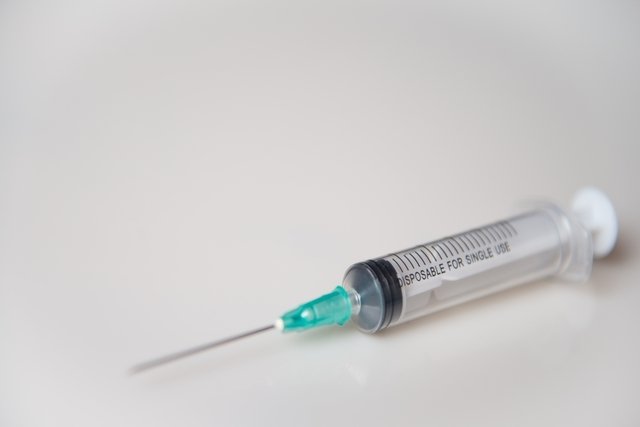Injectable contraceptives are a type of contraceptive method that can be recommended by a gynecologist and which consists of applying an injection every month or every 3 months with the aim of preventing the body from releasing eggs and making the mucus in the cervix thicker. thick, thus preventing pregnancy.
The injection must be administered intramuscularly by the gynecologist and may consist of progesterone alone or a combination of progesterone and estrogen. Thus, some of the injectable contraceptives that may be recommended by the doctor are Cyclofemina, Mesigyna, Perlutan, Ciclovular and Uno Ciclo.

How it works
Injectable contraceptives work in a similar way to the contraceptive pill. Due to its hormonal composition, it is capable of inhibiting the release of eggs, in addition to making cervical mucus thicker and reducing the thickness of the endometrium, preventing the passage of sperm and, consequently, fertilization and pregnancy.
However, despite preventing pregnancy, it is recommended that condoms be used in all sexual relations, as this contraceptive method does not prevent sexually transmitted infections. Furthermore, if one of the applications is not performed, there is a risk of pregnancy, as circulating hormone levels decrease.
Monthly injectable contraceptive
The monthly injectable contraceptive must be applied up to the 5th day after the beginning of the menstrual cycle, with another dose being taken after 30 days, this is because after the injection the levels of estrogen and progesterone vary over time, so that These levels need to be replaced to have the contraceptive effect.
Although this type of contraceptive is made up of progesterone and estrogen, the amount of progesterone is not as high and, therefore, the woman may experience fewer adverse effects.
Quarterly injectable contraceptive
The quarterly injectable contraceptive is normally composed only of progesterone, which is slowly absorbed by the body and guarantees the contraceptive effect for longer. This contraceptive must be applied until the 5th day of the beginning of the menstrual cycle and works for up to three months in the woman’s body, requiring another application after this period to keep the cervical mucus thicker and reduce the risk of pregnancy.
Although this type of contraceptive has the advantage of being applied every 3 months, if the woman decides to become pregnant, the return of fertility happens very slowly, usually months after the application of the last injection, in addition to being associated with a greater number of adverse effects. Understand how quarterly injectable contraceptives work.

How to use injectable contraceptives
The injectable contraceptive should be used according to the gynecologist’s instructions, varying according to the woman’s menstrual cycle and whether she uses another contraceptive method.
For women with a normal menstrual cycle, who do not use the pill or another contraceptive injection, the first injection must be taken by the 5th day of the start of menstruation and the following injections must be administered every 30 days, plus or minus 3 days, regardless of menstruation. If the new injection is delayed by more than three days, the woman should be advised to use a condom.
To start after giving birth, the woman must take the injection between the 21st and 28th day after the birth of the baby, and to start using it after an abortion or after taking the morning-after pill, you can take the injection immediately.
You can also take your first injection on the same day you decide to change your contraceptive pill or quarterly injection. However, if the woman has not used any contraceptive method before and has had sexual intercourse, she should take a pregnancy test before taking the injection. Find out how to change contraceptives without running the risk of getting pregnant.
When it is not indicated
The monthly contraceptive injection is not recommended for people with hypersensitivity to any component of the product formulation, pregnant women, women who are breastfeeding up to 6 weeks after giving birth, who have current breast cancer or suspected hormone-dependent malignancy. Additionally, women who have severe headaches with focal neurological symptoms, severe hypertension, vascular disease, history of thrombophlebitis or thromboembolic disorder, and history of ischemic heart disease or complicated valvular heart disease.
The injection should also not be used in women with diabetes, nephropathy, retinopathy, neuropathy or other vascular disease or diabetes lasting more than 20 years, systemic lupus erythematosus with positive antiphospholipid antibodies, a history of liver disease, who have had surgery for large with prolonged immobilization, who suffer from abnormal uterine or vaginal bleeding or who smoke more than 15 cigarettes a day, aged over 35 years.
Main side effects
The monthly contraceptive injection can lead to breast pain, nausea, vomiting, headache, dizziness and the woman can gain weight.
In addition, menstrual changes may occur, and in these cases the woman must be evaluated by a gynecologist to carry out tests to identify whether there is any other cause for the bleeding, such as pelvic inflammatory disease, for example. If there is no apparent cause for heavy bleeding and the woman is not comfortable with this method, it is advised to replace this injection with some other contraceptive method.

Sign up for our newsletter and stay up to date with exclusive news
that can transform your routine!
Warning: Undefined array key "title" in /home/storelat/public_html/wp-content/plugins/link-whisper-premium/templates/frontend/related-posts.php on line 12
Warning: Undefined array key "title_tag" in /home/storelat/public_html/wp-content/plugins/link-whisper-premium/templates/frontend/related-posts.php on line 13



